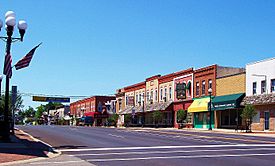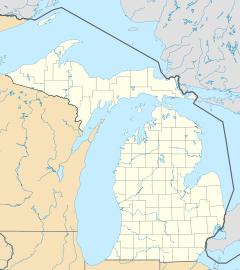Chesaning, Michigan facts for kids
Quick facts for kids
Chesaning, Michigan
|
|
|---|---|
|
Village
|
|

Looking west along Broad Street
|
|

Location within Saginaw County
|
|
| Country | United States |
| State | Michigan |
| County | Saginaw |
| Township | Chesaning |
| Government | |
| • Type | Village council |
| Area | |
| • Total | 3.17 sq mi (8.21 km2) |
| • Land | 3.08 sq mi (7.98 km2) |
| • Water | 0.09 sq mi (0.23 km2) |
| Elevation | 640 ft (200 m) |
| Population
(2020)
|
|
| • Total | 2,430 |
| • Density | 788.96/sq mi (304.65/km2) |
| Time zone | UTC-5 (Eastern (EST)) |
| • Summer (DST) | UTC-4 (EDT) |
| ZIP code(s) |
48616
|
| Area code(s) | 989 |
| FIPS code | 26-15140 |
| GNIS feature ID | 2397613 |
Chesaning (pronounced CHESS-ə-ning) is a village in Saginaw County, located in the state of Michigan in the United States. In 2020, about 2,430 people lived there. The village is part of Chesaning Township.
Contents
History of Chesaning
Early Beginnings and the Saginaw Treaty
The first time Chesaning was mentioned in history was in the Saginaw Treaty, signed in 1819. This important agreement was made between the Chippewa Indians (specifically members of the Saginaw Tribe) and the United States government. They set aside special areas called "reservations." One of these was a 10,000-acre (about 40 square kilometers) area along the Shiawassee River. It was known as "Big Rock Reserve." The name "Chesaning" comes from a Chippewa word that means "big rock place."
New Settlers and a New Name
The treaty lasted until 1837. Then, a second treaty led to the land being measured and sold in 1841. The first pieces of land were sold for $5 an acre. Brothers Wellington and George W. Chapman, along with Rufus Mason, bought this land. They traveled from Massachusetts and brought their families to their new home in the wilderness by late summer of 1842.
While they were away, other settlers had moved into the area. They built a dam and a sawmill to cut wood. A few years later, a gristmill was added to grind grain. The new settlers called their community "Northampton." This was to honor the town of Northampton they had left behind. In 1853, the state government changed the name to Chesaning. This was the traditional name for the village and the surrounding area.
Growth of the Village
The first local elections were held in 1847. This is seen as the official start of the community. The village itself was first measured in 1851 and officially organized in 1869. At first, businesses were on the east side of the river. There was a lot of wood from the forests, which was used to build many stores. However, people used coal for heating, which often caused big fires. These fires destroyed whole blocks of stores. Because of the fires and the arrival of the railroad, businesses moved to the west side of the river.
River and Rail Transportation
In 1857, a company called the Owosso and Saginaw Navigation Company was formed. Their goal was to move goods by barge up and down the river. They started building a canal and a lock on the east side of the dam. This helped boats carry goods on the river. The river was important for trade until the railroad arrived.
The railroad through Chesaning was built in 1867. It was first planned to be about three miles west of Chesaning. It would have gone directly from Oakley to St. Charles. Luckily, Wellington Chapman donated $18,000 to the railroad company. This was a very large amount of money back then! His donation helped make sure the rail line came through Chesaning. The railroad became very important for the village's economy.
Geography
Chesaning covers a total area of about 3.14 square miles (8.13 square kilometers). Most of this area, about 3.05 square miles (7.90 square kilometers), is land. The rest, about 0.09 square miles (0.23 square kilometers), is water.
Transportation
You can get to Chesaning using these routes:
- M-52 (a state highway)
- M-57 (another state highway)
- Great Lakes Central Railroad (a railway line)
Population Information
| Historical population | |||
|---|---|---|---|
| Census | Pop. | %± | |
| 1870 | 721 | — | |
| 1880 | 889 | 23.3% | |
| 1890 | 1,056 | 18.8% | |
| 1900 | 1,244 | 17.8% | |
| 1910 | 1,363 | 9.6% | |
| 1920 | 1,387 | 1.8% | |
| 1930 | 1,594 | 14.9% | |
| 1940 | 1,807 | 13.4% | |
| 1950 | 2,264 | 25.3% | |
| 1960 | 2,770 | 22.3% | |
| 1970 | 2,876 | 3.8% | |
| 1980 | 2,656 | −7.6% | |
| 1990 | 2,567 | −3.4% | |
| 2000 | 2,548 | −0.7% | |
| 2010 | 2,394 | −6.0% | |
| 2020 | 2,430 | 1.5% | |
| U.S. Decennial Census | |||
In 2010, there were 2,394 people living in Chesaning. Most of the people were White (95.9%). There were also small percentages of African American, Native American, and Asian residents. About 4.1% of the population identified as Hispanic or Latino.
Education
Early Schools
Education in Chesaning started in the summer of 1843. A small wooden building was put up on the east side of the river. Eliza Ann Smith was the first teacher. She taught 11 students, including her five younger brothers. Their first school year ended when a big rainstorm flooded the building. The teacher and students had to quickly move to higher ground!
The school moved several times over the years. In 1869, a brick school was built for $14,000. This building was made bigger a few years later. A second brick school was built on the same spot and opened in 1918. A gym was added in 1938, and a band room came a few years later.
Modern Schools
The current high school opened in 1959. It was built to hold 1,000 students. Later, it was made even bigger to fit 1,200 students. Today, the Chesaning Union Schools district includes a high school, a middle school, and one elementary school. The district also serves a large area outside the village.
There is also a private school called Zion Lutheran School. It teaches students from Pre-Kindergarten to 8th grade. It is part of the Wisconsin Evangelical Lutheran Synod.
Local Media
Chesaning has its own local newspaper called the Tri-County Citizen. It started in 1983 and is a free weekly paper. It is delivered to over 19,000 homes in the area. Many residents also read larger newspapers like The Saginaw News, The Bay City Times, the Flint Journal, or the Argus-Press from nearby Owosso.
Chesaning is also important for TV and radio broadcasters in Mid-Michigan. The community is home to three very tall communications towers, almost 1,000 feet high. TV stations like WJRT-TV and WSMH from Flint, and WAQP from Saginaw, have their antennas and transmitters south of Chesaning. These towers help them send strong signals to cities like Flint, Saginaw, Bay City, and Lansing.
You can also receive many radio stations in Chesaning. Some strong local signals come from stations like WSGW, WTLZ, WKCQ, and WILZ in Saginaw. Others include WHNN and WIOG in Bay City, and WOAP and WRSR in Owosso.
Chesaning Showboat Music Festival
Chesaning used to be famous for an annual event called the Showboat. This was a music festival that brought many people to the village. However, the festival was canceled in July 2013. It was stopped because there wasn't enough money to keep it going.
See also
 In Spanish: Chesaning (Míchigan) para niños
In Spanish: Chesaning (Míchigan) para niños


